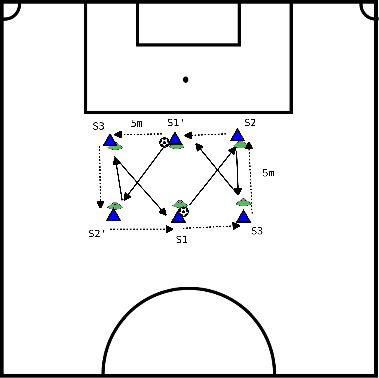Soccer drills
- Distances:
- Rectangle of 15 by 5 meters.
- Pawns B and C 5 meters apart.
- Both 2.5 meters from side and 5 meters from A and D.
- Duration: 10 min.
- After 5 min change direction
Explanation:
- A plays into B
- B drops the ball to C
- C passes to D
- The moment the ball reaches D, A has to be there to make the handball.
- D bounces to A and runs straight through to be played in again.
- A rebounds to D and D rebounds to E.
- E takes ball to starting point.
- Running lines: A becomes B, B becomes C etc.
Points of attention:
- Tight balls by hitting ball in heart, body slightly over ball.
- B must drop ball on C slightly to outside so there is a free pass line to D.
- A must time that he is present at the right time for the handball with D.
- If he is too early and has to wait too long it means in the match there is again opponent in his back.
- Is he too late D has to wait it means in the match that the opponent can put pressure on D.
- To maintain concentration make sure that at point A the ball is not played until everyone is in place.
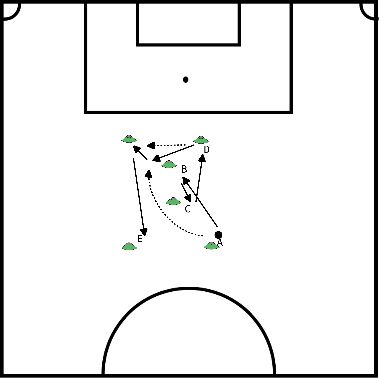
- Distances:
- Rectangle of 15 by 5 meters.
- Pawn B and C 5 meters from each other.
- Both 2.5 meters from side and 5 meters from A and D.
- Duration:
- 10 minutes. After 5 minutes change direction
Explanation:
- A plays into B.
- B drops ball on C.
- C plays D in.
- D takes the ball in the movement.
- D plays it in to E.
- Points of attention:
- Tight balls by hitting the ball in heart, body slightly over ball.
- B should drop the ball on C slightly to outside so that there is a free pass line to D.
- D's assumptions in the movement and pass to E should become a fluid movement so you can perform the action in 2 touches.
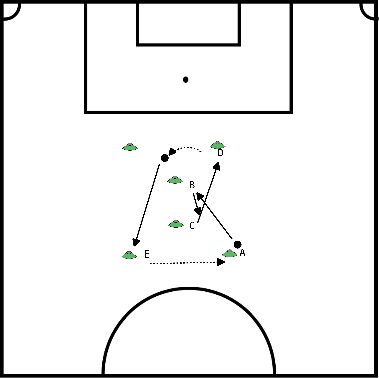
See video
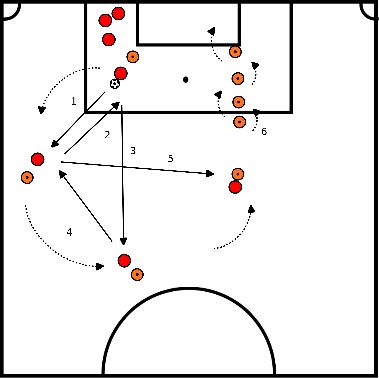
- Staircase 3 variants:
- Each step 1 step.
- Two feet in.
- Foot in foot out.
- Sprint pull up to pawn.
- Slalom around pawn with ball:
- 1x good foot.
- 1x alternate.
- 1x ball rolling under foot left and right.
- One-two with player.
- Dribble through and pass with scissors.
- Then round off.

Distances: compartments 3 by 3 meters.
- Everyone stays in their box.
- Red is going to try to score by shooting the ball into one of the goals.
- The defender opposite the player with the ball steps toward him then to put pressure on the ball.
- The other defenders step in to shield the pass line.
Variants:
Harder: make boxes smaller than 3 x 3 meters.
Easier: make boxes larger than 3 x 3 meters.
Harder: make boxes smaller than 3 x 3 meters.
Easier: make boxes larger than 3 x 3 meters.
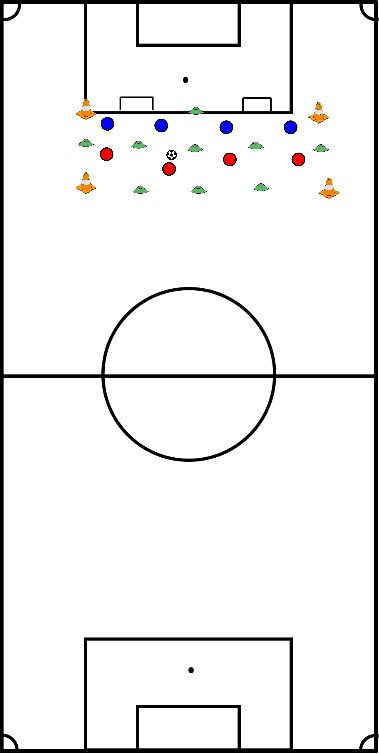
- Put two small goals on the edge of center circle facing each other.
- Make 2 teams with the same number of players.
- These line up next to the goals.
- The players choose a number from 1 to 5. With more than 10 players more numbers.
- The coach passes the ball to the center and calls out a number.
- From each team, the players with the called number play one against one on the goals.
- After a while they choose a new number.
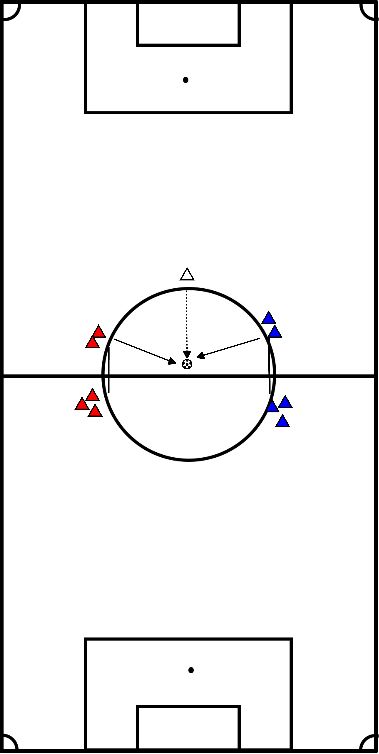
Distance: to the goal 16 meters
Size of squares: 3 by 3.
Assignment:
The defenders try to make it impossible for the attackers to score by shielding the pass lines.
Again, the defender, who has the attacker in front of him, presses with the ball and the rest squeezes in.
The attackers try to get the ball into the 16 to finish.
Rules of play:
Size of squares: 3 by 3.
Assignment:
The defenders try to make it impossible for the attackers to score by shielding the pass lines.
Again, the defender, who has the attacker in front of him, presses with the ball and the rest squeezes in.
The attackers try to get the ball into the 16 to finish.
Rules of play:
- The defenders are not allowed in the attackers' box!!!
- The attackers are allowed into the defenders' box to receive the stabbing ball.
- Once the ball is in the 16, the attackers may score. The defenders may also defend there!!!
- Goalkeeper is free in the 16 to intervene.
- Goal attempt over. Then the attackers become defenders and the defenders get the ball and then join behind as new attackers.
If the attackers cannot get into the 16, you can make it easier for them by making the boxes 1 meter wider.
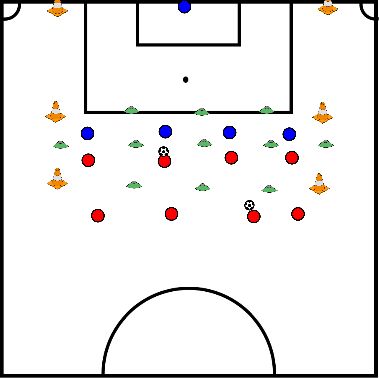
Distances: pawns 2 meters apart.
T= TRAINER.
CV= central defender.
Blue is defense.
Red is offense.
T= TRAINER.
CV= central defender.
Blue is defense.
Red is offense.
Explanation:
Box 1
- Trainer plays ball in to A, the closest man in this case, the CV, step forward to put pressure on player with ball.
- We see a gap created where there is space for the 2 attackers to run in. See the arrows from B&C.
Box 2
- Here we see the solution to cover this running line.
- The moment the defender steps in on the player with the ball, the other players step 1 meter to the middle to close the gap. In this way, no play can be made between them.
- The defender facing the attacker who gets the ball steps forward. The rest must slide inside.
Explanation to players:
- You explain that red are the attackers and blue are the defenders.
- You start in the starting lineup and play attacker A.
- You ask the players; what should the defense do now? Correct answer: opposing defender puts pressure on the man with the ball. Make sure the rest stay put.
- You ask the players; what is created now? Correct answer: space/ running line for the attackers to dive in. Demonstrate this by running one of the attackers into this gap.
- You now ask the players; how can they avoid this? Correct answer: all step in slightly. In this case exactly between the pawns.
Exercise:
- Ball at trainer is always back to beginning lineup.
- Initial exercise is passive, trainer plays to 1 attacker, the defenders take their steps, ball back to trainer.
- Then then play other attacker. Do about 5 minutes until defenders do their job.
- If it goes well quickly, you can make it harder just by increasing the ball pace.
- One step further is to allow the attackers to pass the ball among themselves and not just to the trainer.
- Then switch the attackers and defenders and do the same thing again. Both for about 10 minutes.

- There will be 4 rows of hats, each spaced 10 meters apart. As many lanes as you have pairs.
- Each lane has a 2-pair with 1 ball.
- Players line up at the first 2 rows of hats.
- The ball is at blue's sideline. This passes across the ground to red. This passes back across the ground and runs backwards to the next hats.
- Now blue passes with a firmer pass to red. This one passes back firmly and runs backwards to the last row of hats.
- Then blue passes to red with a high ball and runs himself to the row of hats closest to red.
- Now red stays on the back line and blue runs backwards to the next row of hats after each pass.
Pay attention to good kicking technique and good ball-taking.
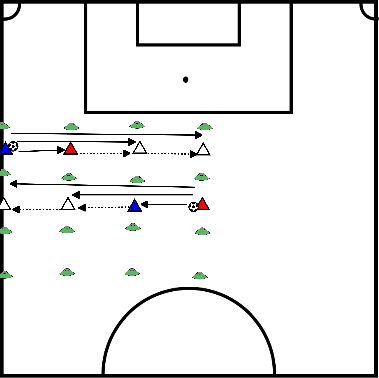
Distances:
- Pawns at 16 width 5 meters.
- Pawns underneath at 10 meters.
- Pawns side 3 meters from the 16 and 5 meters down.
- A stands 10 meters from the pawns.
- A plays the ball to the incoming B and immediately runs himself to the side past the defender.
- B drops the ball on A and goes to his starting position.
- As soon as B drops the ball, C starts running to pass the back.
- A plays the ball in the run along to C.
- C crosses past the last man and then puts the ball back to B.
- B rounds off.
- A becomes B, B becomes C and C retrieves the ball and connects behind and then through the other side
Coach moment:
A after pass immediately run through.
B get loose to ask for ball then immediately take position.
C at right time start not too deep because then too close to CV.
A after pass immediately run through.
B get loose to ask for ball then immediately take position.
C at right time start not too deep because then too close to CV.
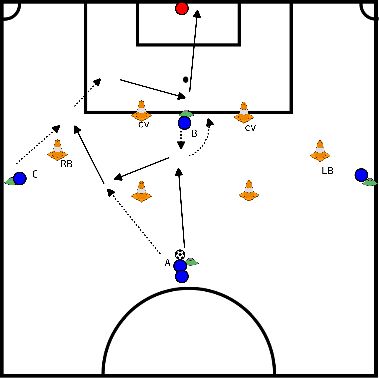
Distances:
- Big pawns outside 16 stand 3 meters outside it.
- Player C 10 meters outside the 16.
- Distance C and B is 10 meters.
- Distance B and A is 5 meters.
- Large pawns are opponents.
- A plays into B.
- B turns away from the opponent inside and crosses the ball between the defenders into C's running line.
- C rounds off.
- A becomes B. B becomes C. C retrieves the ball and closes in behind.
- Then the other side starts.
Coach moment: C not to leave too early otherwise offside also pay attention to this as a coach. Do not leave too late or the goalkeeper will pick up the ball.
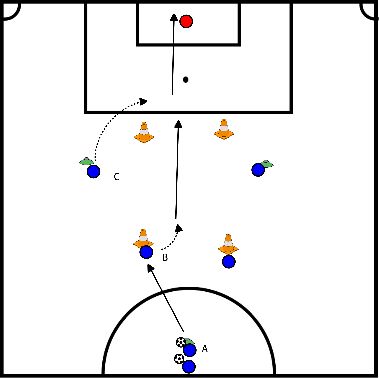
Exercise begins at the two middle cones.
- S1 passes diagonally to S2.
- S2 rebounds to S3.
- S3 rebounds diagonally to S2 who presents at middle cone.
Exercise then continues on the other side.
6 pots, 2 balls and 6 players.
6 pots, 2 balls and 6 players.
